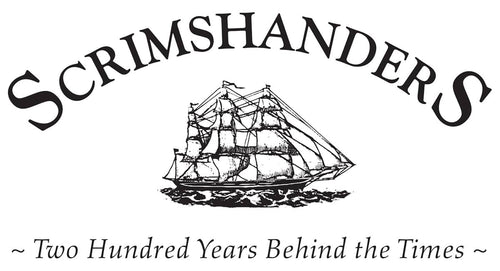19th Century Art in the 21st Century
Keeping the American folk-art of scrimshaw alive, the Kiracofe brothers have been “scratching out a living” for nearly 40 years. Setting up shop first in Boston in 1978 the brothers later established stores on Mackinac Island in 1979, the Door Peninsula 1993, Newport 1986, and in Wickford 2000. Each location offers wares of jewelry, Nantucket baskets, fine knives, and hand-crafted treasures.
Although each Scrimshanders gallery is different, all have an alluring atmosphere into the past. Join us at the Scrimshanders, where we are truly “two hundred years behind the times”.
Scrimshaw History & Materials
The art of scrimshaw is considered to be the only truly American Folk Art. The term “scrimshaw” came into usage in the early American whalers’ logbooks in the later 1700s and early 1800s. It was coined to describe the art of carving on ivory or bone that the whalemen practiced passing time between whale sightings.
These whaling expeditions sometimes lasted 3 or 4 years, with the largest downtime being in between whale hunts. These hunts’ primary goal was the oil produced by rendering down the whale’s blubber and the ambergris (a black tarry substance used in the production of perfume). A by-product of the hunt was the whale’s bones and teeth, which were given to the sailors to carve. This served the dual purpose of keeping them out of trouble on the voyage and providing them with a saleable product to increase their earnings at the end of the voyage.
The men would take the raw sperm whale teeth, smooth down the rough outer ridges with knives and use shark skin as natural sandpaper to smooth it further. The final stop before starting to scrim was to polish the tooth with chamois.
The earliest scrimshanders sometimes used a crude version of the stipple method, which pricks small holes into the ivory and fills them with pigment. A more common method was using their sailors’ needles to carve lines into the teeth they also filled with pigment. Different pigments were used according to what was available. For black, they used lamp black, a combination of carbon and whale oil. Tea, vinegar, berries, and octopus dye were also used to provide a change of color.
Subject matter varies from tales of a whale hunt gone wrong to portraits of their wives and sweethearts. The bone and ivory were made into various practical frivolous objects, including corset stays, hat boxes, rolling pins, swifts, cooking utensils, cribbage boards, and many other things their imaginations could come up with.
While the first scrimshaw was mostly done on whalebone and teeth, other ivories were substituted as available. Elephant, hippo, and walrus ivories were not uncommon pacific dreamscapes. Today we use a variety of ivories, woolly mammoth, fossil walrus, hippo, antique piano keys and ivory cue balls, pre-embargo elephant ivory, and antler bone, buffalo horn, and other ivory substitutes. From these are created intricate pieces of jewelry, pocket knives, and display pieces.
Marine Mammal Protection Act
In 1973 the federal government passed the Marine Mammal Protection Act. After that time, no whale or walrus ivory was allowed to be imported, and only the native people of Alaska were allowed to hunt whale or walrus. In 1989 the Endangered Species Act was passed, which covered Elephant ivory. From that time, NO fresh ivory was allowed to be imported, but what was here was grandfathered in and can be sold in your state.
However, as of February 2020, nine states, California, New York, New Jersey, Hawaii, Washington, Oregon, Nevada, and Illinois, all have total bans on all ivory sales in their states, including fossils, and antiques. Please check with your state Fish and Wildlife Service for any updates to your state laws. Here’s a helpful link to the Federal Law regarding bone and ivory laws.




